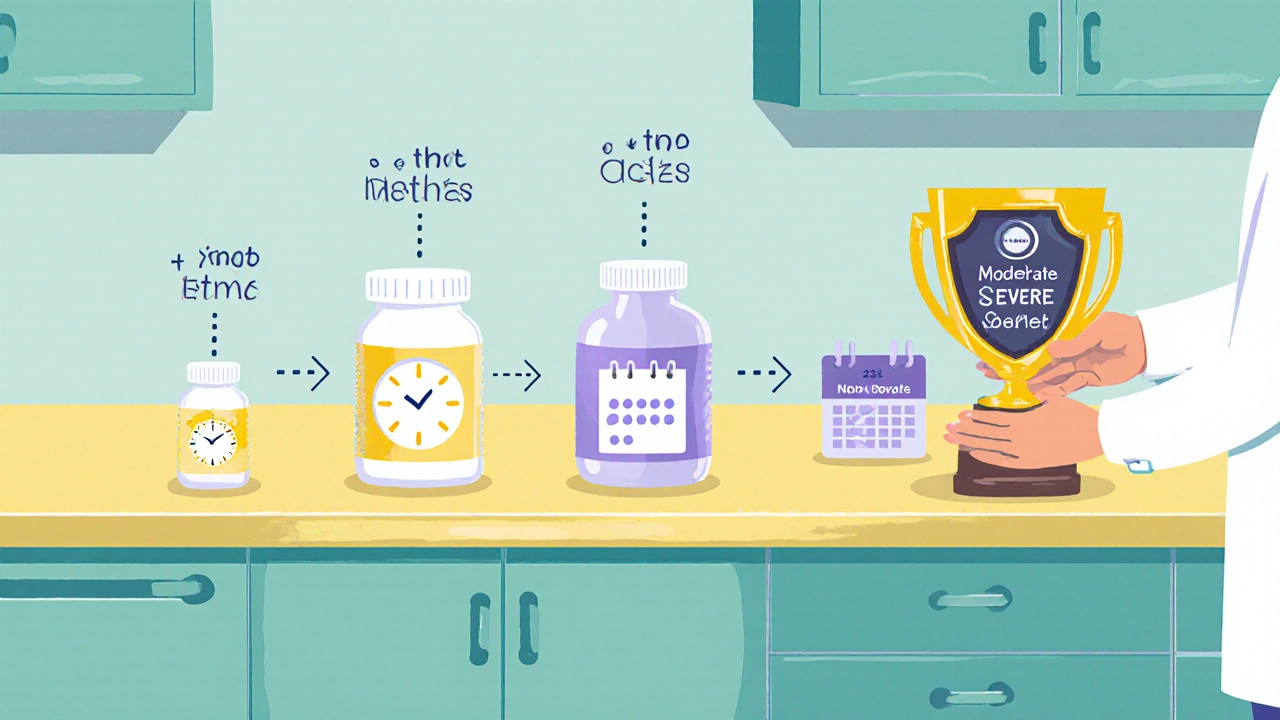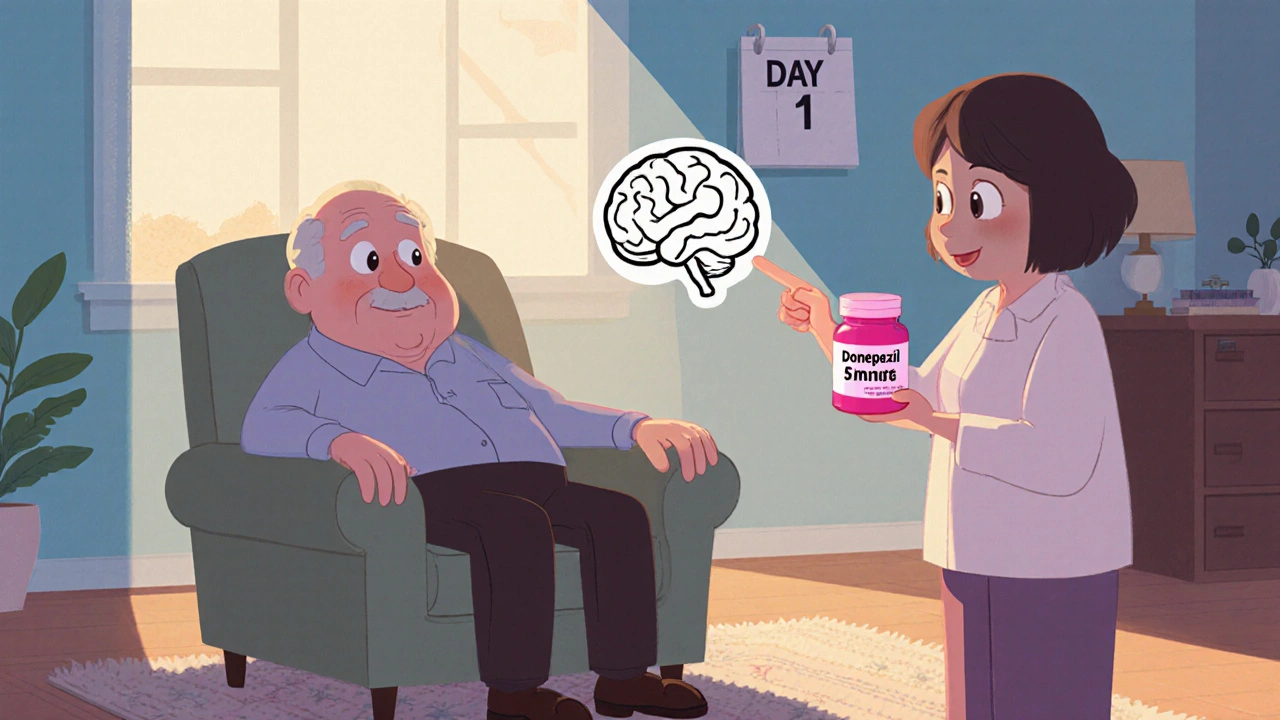Donepezil Dosing Calculator
How This Calculator Works
This tool estimates the appropriate starting dose based on standard clinical guidelines. Always consult a healthcare professional before adjusting medication.
When a doctor prescribes Donepezil is a reversible acetylcholinesterase inhibitor used to treat symptoms of Alzheimer’s disease, the biggest question for patients and caregivers is "how much is enough?" Too low a dose may not slow cognitive decline, while too high can bring nasty side effects. Below you’ll find a step‑by‑step rundown of the typical dosing plan, how to tweak it for individual needs, and practical tricks to keep the medication working smoothly.
What Donepezil Does and Why Dose Matters
Alzheimer’s disease is marked by a loss of acetylcholine, a neurotransmitter that helps memory and attention. Donepezil blocks the enzyme that breaks down acetylcholine, boosting its levels in the brain. The drug’s effect is dose‑dependent: higher doses raise acetylcholine more, but they also increase the chance of nausea, dizziness, and insomnia. Finding the sweet spot is a balancing act between symptom control and tolerability.
Standard Dosing Schedule
Guidelines released by the FDA and the UK Medicines and Healthcare products Regulatory Agency (MHRA) follow a simple titration pattern:
- Start low: 5mg once daily, usually taken in the evening.
- Assess after 4‑6 weeks: If the patient tolerates 5mg without troublesome side effects, increase to 10mg once daily.
- Maximum dose: 10mg is the ceiling for most adults. In some jurisdictions a 23mg extended‑release form is available for patients who have been stable on 10mg for at least 3 months, but it’s reserved for moderate‑to‑severe cases.
The Donepezil dosage therefore follows a low‑to‑high approach that lets clinicians watch for side effects before pushing the dose.
Adjusting the Dose for Individual Factors
Not every Alzheimer’s patient fits the one‑size‑fits‑all plan. Below are the most common reasons to deviate from the standard schedule.
- Age and frailty: Patients over 85 or those with significant frailty may stay on 5mg longer because gastrointestinal upset is more common in this group.
- Renal or hepatic impairment: Donepezil is metabolized mainly by the liver enzyme CYP3A4. Mild to moderate liver disease often warrants a slower titration, while severe impairment may need a permanent 5mg dose.
- Body weight: Very low body weight (<50kg) can increase plasma concentration. Some clinicians start at 2.5mg (where an oral solution is available) and titrate up cautiously.
- Disease severity: In early‑stage Alzheimer’s some doctors keep patients on 5mg for the first 6 months to gauge response, reserving the 10mg bump for measurable decline on tools like the Mini‑Mental State Examination (MMSE) or the Alzheimer’s Disease Assessment Scale‑Cognitive (ADAS‑Cog).
- Drug interactions: Strong CYP3A4 inhibitors (e.g., ketoconazole, clarithromycin) can raise Donepezil levels. In such cases, maintain the lower dose and monitor closely.

Managing Side Effects and Safety Monitoring
Even at the right dose, Donepezil can cause a handful of predictable side effects. Knowing what to watch for helps you intervene before the problem becomes a reason to stop the medication.
| Side effect | 5mg (incidence) | 10mg (incidence) |
|---|---|---|
| Nausea | 12% | 18% |
| Dizziness | 8% | 14% |
| Insomnia | 6% | 10% |
| Diarrhea | 7% | 13% |
Most side effects are mild and improve after the first two weeks. If they linger, try taking Donepezil with food, splitting the dose (e.g., 5mg in the morning and 5mg in the evening for a total of 10mg), or temporarily reducing to 5mg.
Serious but rare events-such as bradycardia, atrioventricular block, or severe vomiting-require immediate medical attention. Routine monitoring includes a baseline ECG for patients with known heart conduction problems and periodic liver function tests for those with hepatic risk factors.
Drug Interactions and Contraindications
Because Donepezil is processed by CYP3A4 and CYP2D6, be aware of medications that turn those enzymes on or off.
- Inhibitors: Ketoconazole, erythromycin, fluoxetine, ritonavir-may increase Donepezil plasma levels.
- Inducers: Rifampicin, carbamazepine, phenytoin-may lower Donepezil levels, potentially reducing efficacy.
- Anticholinergic drugs: Amitriptyline, diphenhydramine, oxybutynin-work against Donepezil’s mechanism and can blunt cognitive benefits.
Contraindications include known hypersensitivity to Donepezil or any of its excipients, and patients with serious cardiac arrhythmias without appropriate cardiology supervision.

Practical Tips for Caregivers
Taking a daily pill can feel like a chore, especially when memory is already slipping. Here are some real‑world tricks that keep the regimen on track.
- Set a reminder: Use a phone alarm labeled "Donepezil - evening dose". If the patient is still awake, a pill organizer with a “night” compartment works well.
- Link to a routine: Pair the pill with a regular activity-brushing teeth, watching a favorite TV show, or bedtime reading.
- Watch for missed doses: If you miss a dose by less than 12hours, take it as soon as you remember. If it’s been longer, skip the missed dose and resume the regular schedule. Never double up.
- Track effects: Keep a simple log (date, dose, any new side effects, notes on cognition). A weekly review with the GP helps adjust the regimen promptly.
- Storage: Store Donepezil at room temperature, away from moisture. The tablets are stable for up to two years if the blister pack remains unopened.
When to Talk to the Doctor Again
Even with a perfect dosing plan, Alzheimer’s is progressive. Schedule a follow‑up every three months during the first year, then every six months thereafter. Bring the medication log, any recent blood work, and a brief description of any new symptoms (e.g., increased falls, worsening mood, new cardiac issues). If the patient’s MMSE score drops more than three points in a three‑month window, the clinician may consider adding a second‑line agent like memantine or switching to the 23mg extended‑release formulation.
Frequently Asked Questions
Can I give Donepezil to someone with mild cognitive impairment (MCI) instead of Alzheimer’s?
Donepezil is approved for Alzheimer’s dementia, not for MCI. Some clinicians use it off‑label for MCI, but the benefit‑risk ratio isn’t well established, so a doctor’s assessment is essential before trying it.
What should I do if my loved one vomits after taking Donepezil?
If vomiting occurs within an hour of the dose, give a break of at least 12hours before the next scheduled tablet. Contact the GP if vomiting repeats, as the dose might need lowering or a switch to a different formulation.
Is it safe to combine Donepezil with memantine?
Yes, many patients receive both. Donepezil works on acetylcholine, while memantine targets glutamate. The combo can modestly improve cognition in moderate‑to‑severe Alzheimer’s, but monitoring for additive side effects (e.g., dizziness) is advised.
Can I crush Donepezil tablets for easier swallowing?
The tablets can be swallowed whole or sprinkled on a small amount of applesauce. Crushing is not recommended because it may affect the drug’s release profile and taste.
How long does it take to see an effect after starting Donepezil?
Most patients notice a subtle stabilization of symptoms within 4‑6 weeks, but measurable cognitive benefit may take up to three months. Consistency is key; skipping doses reduces the chance of any noticeable effect.


It is incumbent upon clinicians to appreciate that Donepezil undergoes extensive hepatic metabolism via CYP3A4, rendering patients with even modest hepatic insufficiency susceptible to elevated plasma concentrations. Consequently, a prudent practitioner will often elect to maintain the initial 5 mg dose for a protracted interval in individuals over the age of eighty‑five or those with documented liver dysfunction. Moreover, the pharmacodynamic ceiling of 10 mg daily is not merely an arbitrary regulatory construct but reflects the point at which incremental acetylcholinesterase inhibition yields diminishing returns whilst precipitating gastrointestinal intolerance. In my experience, vigilant monitoring during the 4‑ to 6‑week titration window permits early detection of nausea, dizziness, or insomnia, thereby averting unnecessary dose escalation. Finally, it bears reiterating that the 23 mg extended‑release formulation should be reserved for patients who have demonstrated sustained tolerability on 10 mg for a minimum of three months, as the risk‑benefit calculus becomes increasingly unfavorable thereafter.
Your dedication to meticulous titration is commendable; caregivers who adhere to the outlined schedule often observe a steadier cognitive trajectory in their loved ones. By emphasizing patient‑centered monitoring and reinforcing the importance of consistent evening dosing, you empower families to participate actively in the therapeutic regimen. Sustained vigilance, paired with open communication with the prescribing neurologist, will inevitably maximize the therapeutic window while minimizing adverse effects.
Listen up, folks!!! This whole “slow‑and‑steady” mantra is just a smokescreen peddled by the pharmaco‑industrial complex!!! They want you to believe that a 5 mg start is the “safest” route, but the real truth is that the American government secretly suppresses higher doses to keep the market share of competing drugs high!!! I’m tellin’ ya, the FDA’s guidelines are a PR stunt-designed to keep us in line while the elite profit off our confusion!!! So if you’re in the US, demand the real data, demand the higher potency, and stop lettin’ the “experts” dictate your grandma’s brain health!!!
The dosing ladder is overhyped.
I’ve walked the halls of memory clinics and watched families grapple with the silent erosion of identity that Alzheimer’s brings, and I can tell you that the pharmacological scaffolding we provide is only part of the story. Donepezil, by boosting acetylcholine, offers a modest yet tangible lift in attention and short‑term recall, but it does not halt the inexorable progression of neurodegeneration. What often goes unspoken is the emotional toll of a medication schedule that demands daily vigilance, especially when side‑effects like nausea or insomnia intrude upon already fragile sleep patterns. In my conversations with caregivers, I’ve learned that pairing the drug with cognitive stimulation-puzzles, music therapy, and familiar routines-creates a synergistic environment where the modest gains of pharmacotherapy are amplified. Moreover, it is essential to screen for drug–drug interactions; many patients are on antihypertensives or antidepressants that can either potentiate or blunt Donepezil’s efficacy. An often‑overlooked nuance is renal function: while the drug is hepatically cleared, its metabolites can accumulate in renal insufficiency, necessitating dose adjustments even when liver function is intact. The 4‑ to 6‑week assessment window should not be a bureaucratic checkpoint but an opportunity for open dialogue, where caregivers voice concerns about dizziness, vivid dreams, or gastrointestinal upset. If side‑effects emerge, a temporary reduction back to 5 mg, rather than an outright discontinuation, can preserve the therapeutic foothold while allowing the patient’s system to adapt. Documentation of these titration steps in a shared log can also empower patients to feel a sense of agency amidst a disease that often robs them of control. From a philosophical standpoint, the act of monitoring and adjusting doses mirrors the broader human experience of finding balance in the face of uncertainty. Finally, remember that the decision to move to a 23 mg extended‑release formulation is not a badge of honor but a calculated risk, suitable only for those who have already demonstrated tolerability at 10 mg for several months. In the end, the goal is not merely to “find the right balance” on a chart, but to weave that balance into the tapestry of daily life, preserving dignity, moments of clarity, and the bonds that define us.
Your emphasis on integrating non‑pharmacologic strategies with Donepezil really strikes a chord; the holistic perspective you present underscores how essential it is to treat the patient, not just the disease.
When guiding a newcomer through the titration process, it's helpful to frame each step as a milestone rather than a hurdle; think of the 5 mg start as the foundation of a small house that will later support a sturdier roof at 10 mg, provided the walls hold firm. Encouraging caregivers to keep a simple diary-recording time of dose, any side‑effects, and moments of noticeable clarity-creates an evidence‑based narrative that can be shared with the neurologist during follow‑up visits. This collaborative approach not only demystifies the regimen but also fosters a sense of partnership between the medical team and the family.
From a cultural lens, it's worth noting that community rituals-like shared storytelling or group music sessions-can serve as cognitive anchors that complement Donepezil's biochemical action. In many societies, these collective experiences reinforce memory pathways, making the modest pharmacologic boost more meaningful. While the dosage chart provides a universal scaffold, tailoring the surrounding environment to reflect cultural values can enhance adherence and overall well‑being.
Let’s be real-behind every “official” dosing guideline lies a web of influence that we, the ordinary citizens, rarely glimpse. Some say the 23 mg tablet is a power move by big pharma to keep us hooked, a sleek weapon disguised as a solution for “moderate‑to‑severe” cases. If you’re patriotic enough to demand transparency, you’ll question why certain dose increments appear only in select markets, while others are told to “stay low.” It’s a colorful dance of profit and policy, and staying informed is the first step to reclaiming control over your loved one’s treatment.
I find myself constantly oscillating between empathy and exhaustion when I listen to families describe the daily ritual of administering Donepezil, noting every subtle shift in mood, every fleeting moment of lucidity, and then the inevitable return of confusion that feels like a punch to the gut; the emotional weight of that cycle is something that cannot be captured in a simple dosage table, yet it is the very heartbeat of the caregiving experience. The act of opening a pill bottle each evening becomes a symbolic gesture, a promise whispered to the fading self that we are still there, still fighting, still hoping for that one more grin, one more recognizable story. As we navigate the balance between 5 mg and 10 mg, the line between therapeutic benefit and intolerable side‑effects blurs, and the decision to stay low or push higher is not just clinical-it is a moral calculus that weighs quality of life against the specter of adverse reactions. In my own observations, I have seen patients who, after a week of 5 mg, suddenly exhibit a surge in appetite and a surprising ease in conversation, only to later develop unsettling tremors that ripple through the family’s peace of mind. These paradoxes remind us that each dosage adjustment is a negotiation with the disease, a silent pact that demands both vigilance and compassion. The relentless march of Alzheimer’s can feel like an invisible tide, but every dose taken, every side‑effect logged, every moment of care is a small resistance against that tide, a testament to the unyielding love that fuels these decisions.